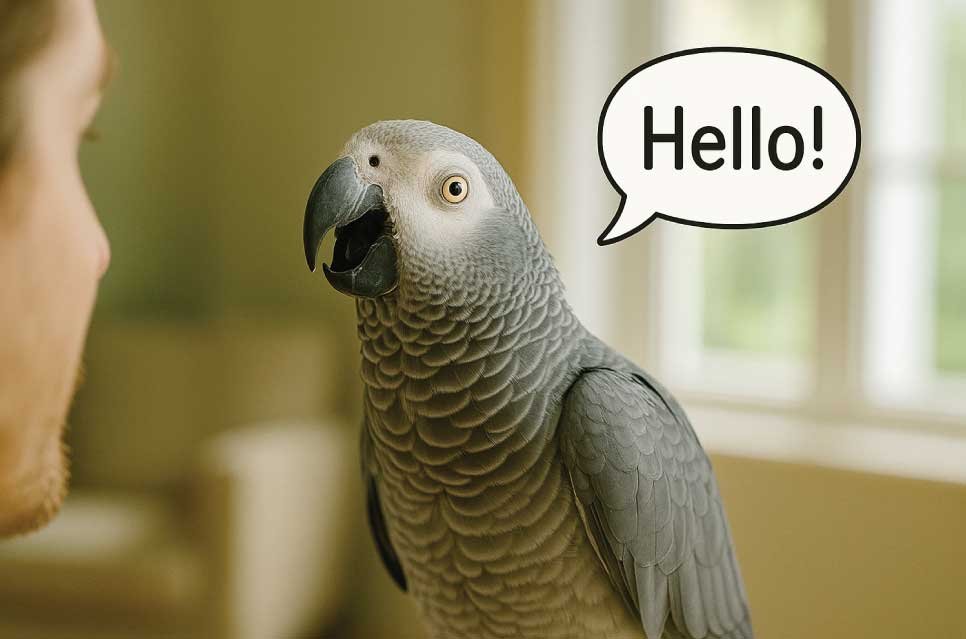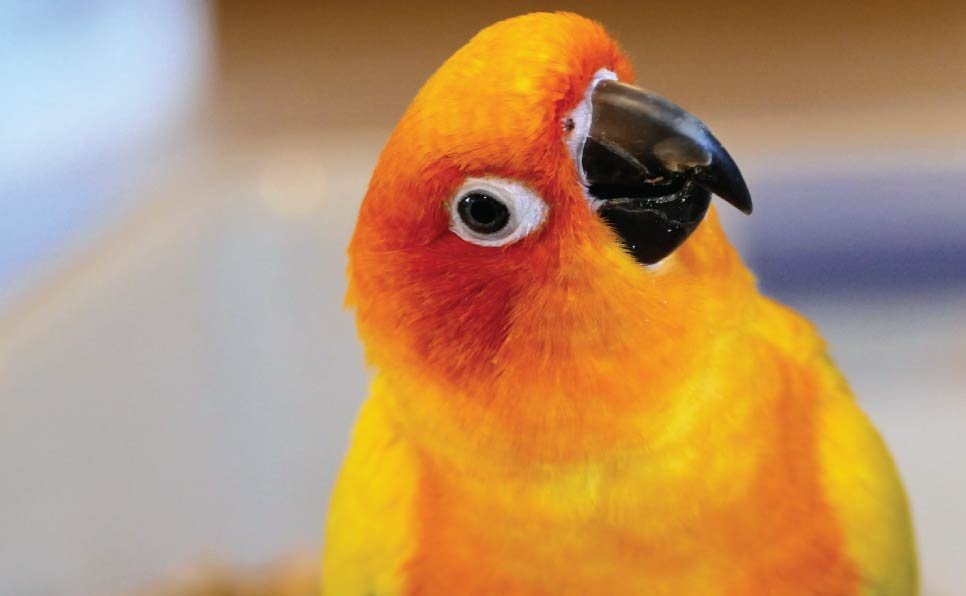Want your feathered friend to chat back? Teaching your pet bird to talk isn’t just about mimicry, it’s about building trust, communication, and a bond that lasts a lifetime. Birds are naturally social creatures, and when they join our homes, they want to connect with their new human flock. With patience, repetition, and love, you can help your bird go from mimicry to meaningful conversation.
At PetSweetJoy, we believe that teaching a bird to talk is more than a fun trick, it’s a way to build understanding and emotional connection. As with all relationships, it starts with trust and grows with shared experiences.
Listen to the Podcast: How to Teach Your Pet Bird to Talk
Establishing the Foundation (Aptitude and Trust)
Before saying the first word, you need to understand your bird’s natural abilities and emotional readiness.
Which Birds Are the Best Talkers? (Aptitude).
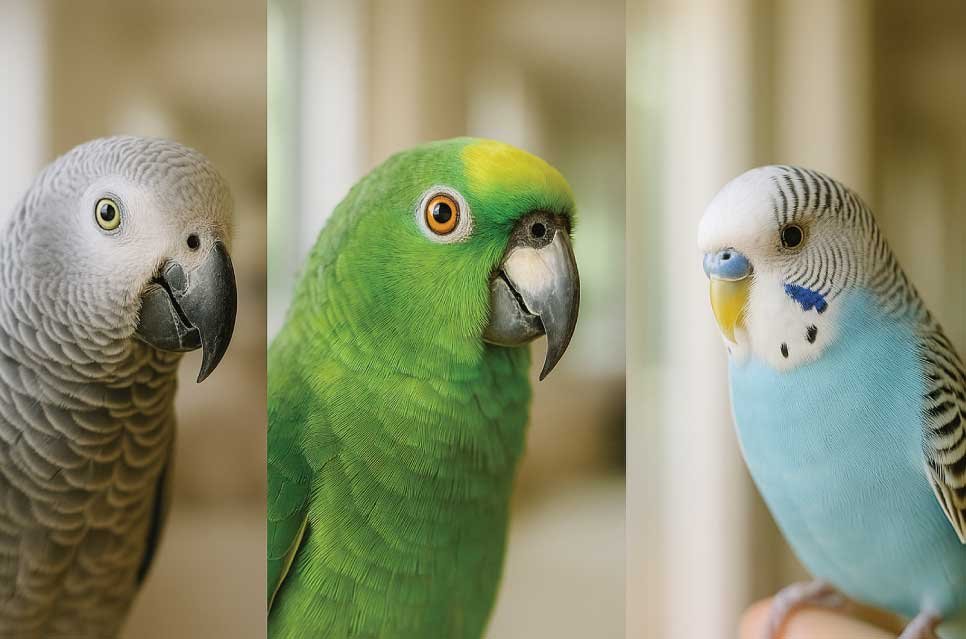
Not every bird species has the same ability to mimic human speech. Some are natural chatterboxes, while others prefer whistles or sounds. Understanding your bird’s potential helps set realistic goals and keeps training positive.
The best talkers include:
- African Grey Parrots: Known as the geniuses of the bird world, they can understand context and use words meaningfully. (Learn more in our Exotic Bird Guide)
- Amazon Parrots: Clear, loud, and confident talkers, great companions for dedicated trainers.
- Budgerigars (Budgies): Small in size but big in voice! They often mimic words better when spoken in an excited, high-pitched tone. For more on their social nature, see Do Budgies Need to Be in Pairs?
While young birds are generally easier to train, you can absolutely teach an older bird to talk with consistency and patience. Every bird learns at their own pace, think of it like teaching a grandparent how to use emojis.
Building the Flock Bond (Trust)
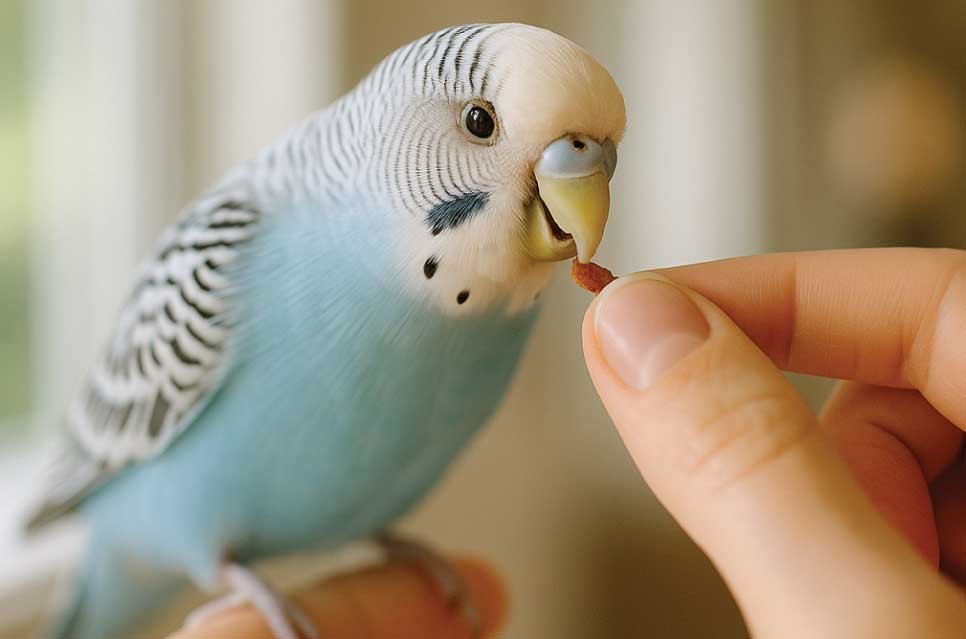
Trust is the foundation of all communication. A bird will only talk if it feels secure and emotionally connected to you.
To build trust:
- Be a provider of good experiences. Offer treats, gentle head scratches, soft talking, and playtime. Let your bird associate your presence with comfort and safety.
- Spend calm time together. Sit near their cage, talk softly, and let them get used to your voice.
- Respect boundaries. Don’t force handling. Allow the bird to come to you at its own pace.
At PetSweetJoy, our philosophy comes from years of living with adopted pets, animals who needed extra patience and reassurance. Trust isn’t instant; it’s built through kindness and routine.
Core Training Mechanics and Environment
Once your bird trusts you, it’s time to create an environment where learning can flourish.
Creating the Optimal Learning Environment
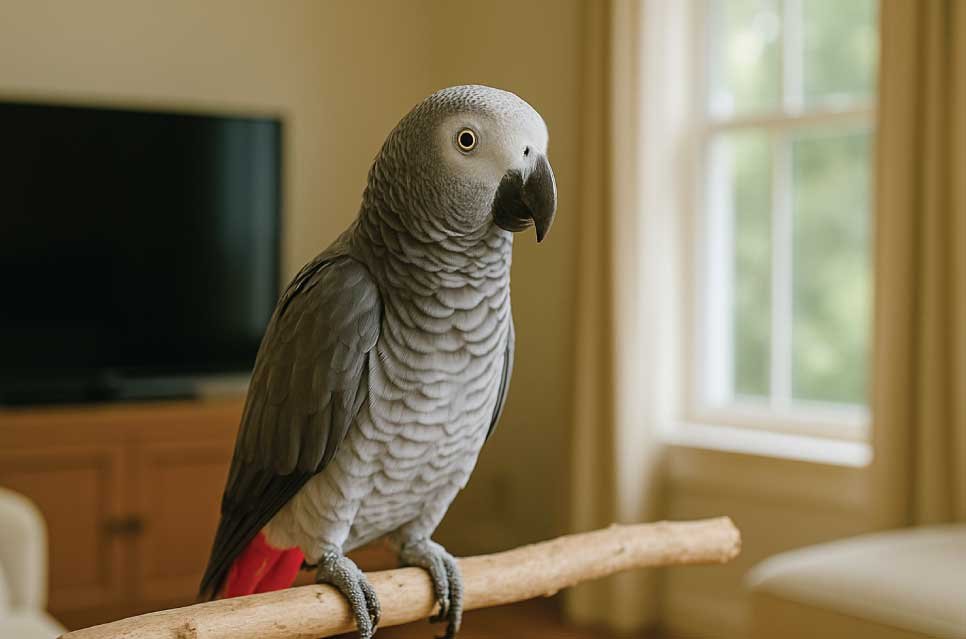
Birds are easily distracted, so your training setup should be both calm and engaging.
Key elements for success:
- Location: Choose a space with daily social interaction, like a family room. Birds learn best when they feel part of the family flock.
- Quiet surroundings: Turn off the TV and loud appliances. Background noise competes with your bird’s focus.
- Timing: The best sessions are usually in the morning or late afternoon when birds are alert.
- Short sessions: Keep lessons to 5–10 minutes, multiple times per day. Frequent repetition works far better than long sessions.
For a deeper look into training habits, check out How Long Does It Take to Train a Bird?
The Power of Repetition and Consistency
Birds learn through imitation and emotion. Consistency makes your voice part of their daily soundtrack.
Tips for repetition:
- Start simple: Use short, easy words like “Hello,” “Hi,” or your bird’s name.
- Use emotion: Birds pick up words they hear when you’re happy or excited. Use a cheerful, sing-song voice.
- Repeat naturally: Incorporate the target word in daily routines. For instance, say “Hello” every morning or “Bye-bye” when leaving the room.
Consistency builds understanding, your tone, energy, and patience tell your bird that communication is rewarding and safe.
Positive Reinforcement: Your Bird’s Major Motivation
Positive reinforcement turns learning into fun. Birds are motivated by affection and food, so pair new words with rewards.
Ways to reward talking attempts:
- Reward Everything: Positive reinforcement really helps because food is a major driving force in a bird’s behavior. Rewards include delicious treats (like seeds, nuts, or pieces of fruit), verbal encouragement (“Good job!”), and gentle stroking (if your bird enjoys being touched).
- Reward Attempts: Reward your bird when it tries to talk, even if it only makes a soft mumbling sound.
- Treat Specialization: Choose your bird’s favorite treat and save it exclusively for training so that they will work extra hard for it.
To keep training engaging, you can also introduce DIY Parrot Toys for enrichment between sessions.
Advanced Training, From Words to Meaning
Once your bird starts mimicking, it’s time to move beyond repetition and teach meaning. This transforms sound imitation into real communication.
Linking Words to Function and Reference
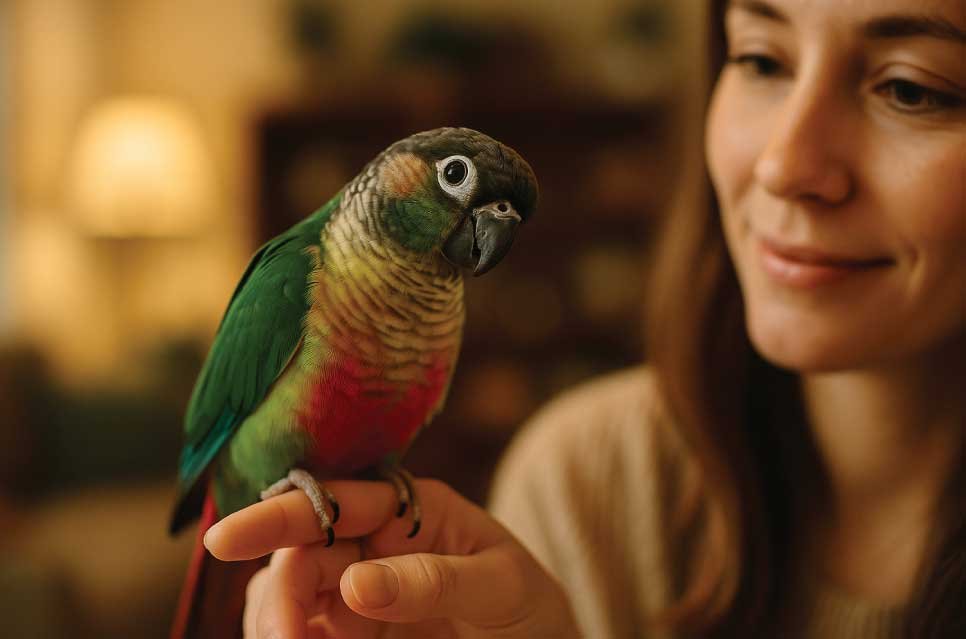
Birds like African Greys have shown remarkable ability to connect words with meaning, the famous parrot Alex could identify colors, shapes, and even express wants. You can help your bird do the same.
Two types of learning:
- Function (Power Words): Teach words that help your bird get what it wants. For example, if it says “apple” and you hand over apple slices, the word gains meaning.
- Reference (Naming Objects): Link words to specific things. Always say the object’s name (“toy,” “perch,” “key chain”) as you offer it.
Reward the communication act itself. Even if your bird says the wrong word, still respond positively, it shows they understand that speaking brings results.
Advanced Vocal Techniques
As your bird grows confident, use these gentle strategies to expand vocabulary:
- Sentence framing: Introduce new words in short phrases, e.g., “Want some apple?” or “Pretty bird!”
- Phonetic play: Sound out tricky words slowly (“Crrr…ris…mus!”) to help birds practice.
- Two-way talk: If your bird says something like, “Hello!” respond with enthusiasm: “Hi there!” This models conversational turn-taking.
- Family roleplay: Encourage everyone in the household to use the same phrases. Birds learn faster when words come from multiple familiar voices.
Want to know more about the world’s most talkative species? Don’t miss 9 Pet Birds That Talk.
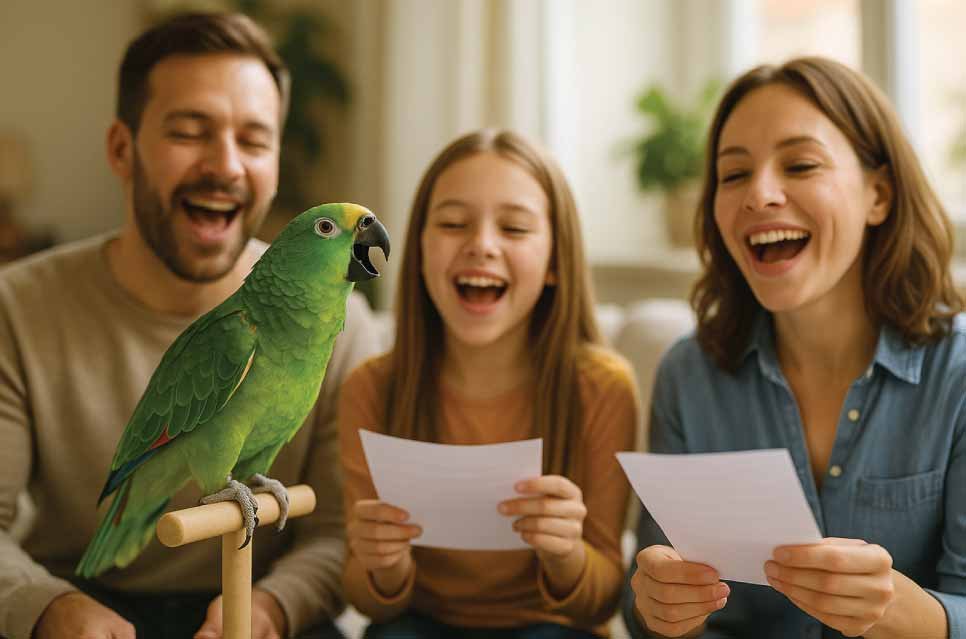
Troubleshooting and Managing Expectations
Even with the best care, training doesn’t always go as planned. Patience is everything.
Be Patient, Progress Takes Time
Some birds pick up speech within weeks; others take months or years. Each has its own rhythm.
If progress stalls:
- Check that your bird feels safe and relaxed.
- Avoid training during stressful periods (new environments, loud noises, or illness).
- Rotate words occasionally to maintain interest.
Remember, the goal is joyful communication, not perfection. If your bird never speaks, they’re still expressing love through chirps, whistles, and body language.
Dealing with Undesirable Words or Sounds
Birds are master imitators, which can sometimes lead to awkward moments.
To manage unwanted mimicry:
- Ignore it completely. Any reaction reinforces the behavior.
- Never punish. Scolding creates fear and breaks trust. Simply turn away or leave the room briefly.
- Be cautious with whistling. Once learned, it can replace speech. Wait until your bird has a decent vocabulary before teaching tunes.
At PetSweetJoy, we’ve learned from experience with rescued pets that gentle guidance always works better than correction. It keeps the relationship loving and the learning enjoyable.
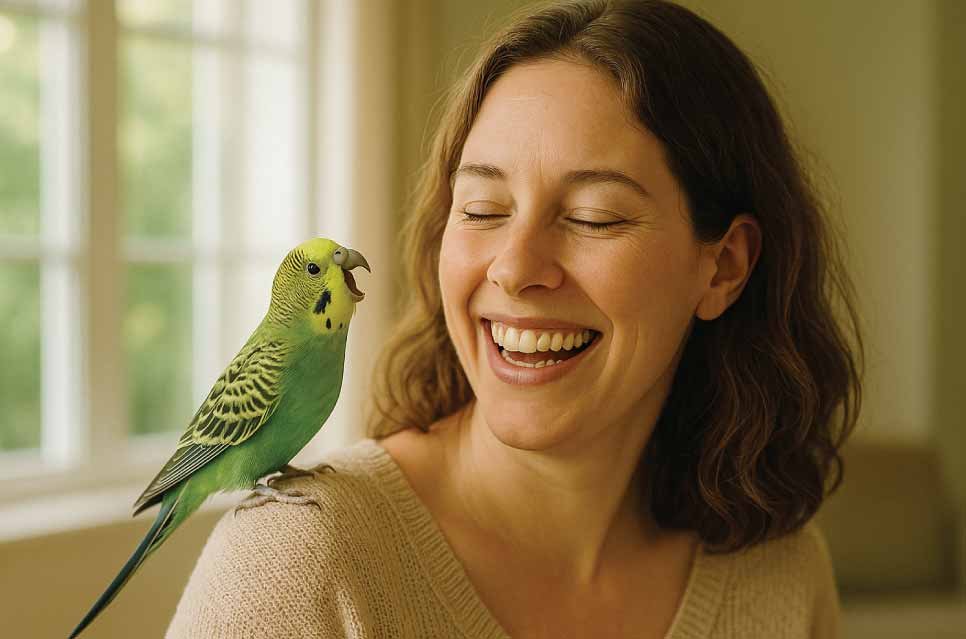
Moving Toward Advanced Communication
Once your bird starts speaking consistently, you can encourage more complex interactions.
Ideas for next-level training:
- Teach short sentences. Build on words your bird already knows (“Good bird!” “I love you!”).
- Create conversations. Ask questions and respond as if your bird answered. This builds rhythm and curiosity.
- Sing together! Birds love music. Try repeating simple nursery rhymes or melodies. African Greys and Budgies, especially, can match rhythm and pitch.
Every word your bird learns becomes part of your shared language, a bridge between species made of trust, sound, and joy.
Final Thoughts: Treasure the Journey
Teaching your bird to talk is about connection, not competition. Whether your companion learns ten words or two hundred, what truly matters is the trust and joy you build together.
At PetSweetJoy, we believe that communication is an expression of love. Every chirp, whistle, and word is a sign of your bond growing stronger. Our founder’s experience with adopted pets taught us that patience and empathy are what turn training into friendship.
So, keep your lessons fun and brief. Reward every effort, celebrate every sound, and enjoy each moment of progress. And remember: your bird may surprise you one day by saying exactly what your heart needs to hear.
If you’re ready to explore more about caring for your feathered friend, check out our guides like Best Pet Birds for Beginners and Bird Health: Common Pet Bird Diseases.
Subscribe to our newsletter for weekly pet happiness tips, personal experiences, and stories that celebrate the joy of living with animals who speak to our hearts, sometimes literally!
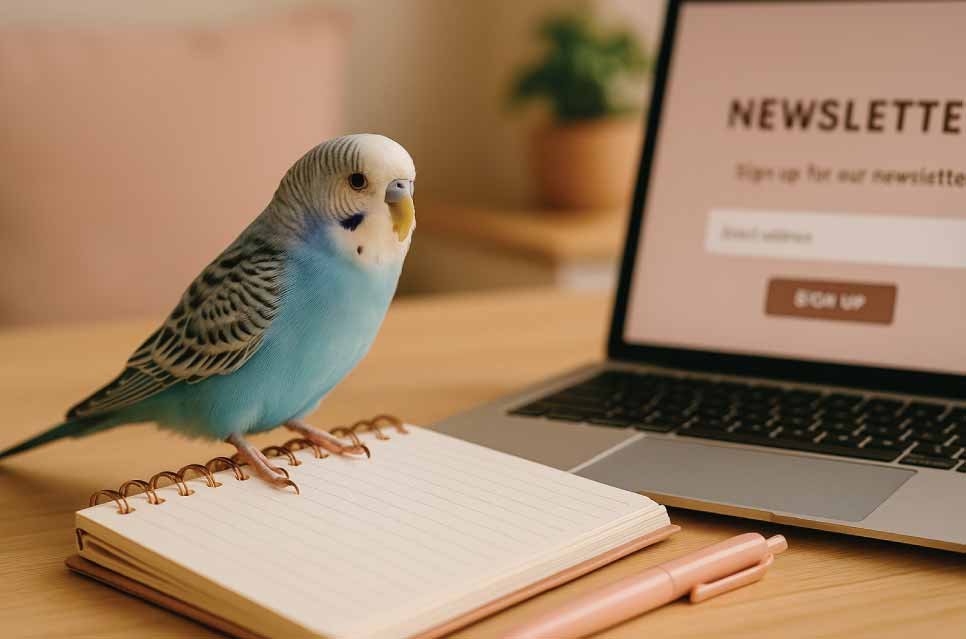
How to Teach Your Pet Bird to Talk: Frequently Asked Questions (FAQs)
Yes, both male and female birds can learn to talk, though some species show differences in ability. Male budgies and Indian ringneck parrots are often more vocal, but female African Greys and Amazons can be equally talented. The key isn’t gender, it’s trust, repetition, and the bird’s individual personality. Every bird is unique, so give both males and females equal opportunities to “find their voice.”
You can start gentle vocal interaction as soon as your bird is comfortable and eating on its own, typically around the weaning stage (2–3 months). Early exposure to human speech helps them get used to your tone and rhythm. But remember: older birds can still learn! They may take a bit longer, but many adult parrots learn to speak after adoption once they feel secure in their new homes.
That’s completely normal. Whistling and mimicry are part of their natural learning process. Some birds communicate primarily through tunes or household noises before forming clear words. Keep encouraging vocal play, celebrate whistles and sounds with positive attention. Over time, your bird may transition from imitation to speech as trust and confidence grow.
Occasional background sound can help prevent loneliness, but constant noise may confuse or stress your bird. If you leave music or gentle chatter playing, choose soft, calm voices or nature sounds instead of loud or fast-changing programs. Birds learn best from direct, emotional interaction with you, not from random voices. So keep the TV for company, not for lessons.
No, talking is just one part of enrichment. Birds also need toys, puzzles, flight time, and social play to stay mentally balanced. In fact, the best talkers are often those with a rich environment and strong bonds. Combine vocal sessions with playtime, climbing, or foraging. You can make it fun with easy homemade activities, like those in our DIY Parrot Toys Guide.
Sudden silence can be a sign of stress, illness, or environmental change. Birds often go quiet when something feels off, new cage location, different family schedule, or not feeling well. Try to identify recent changes and restore familiar routines. If silence persists, consult an avian vet to rule out health issues. Remember, your bird’s voice is a reflection of its comfort, when they feel secure, they’ll start chatting again.
Pro Tip from PetSweetJoy
Every bird learns at its own rhythm. Some will become full-blown chatterboxes, others will express love through whistles or mimicry. What matters most is the trust and joy you share, because when a bird feels safe, that’s when the real conversation begins.

